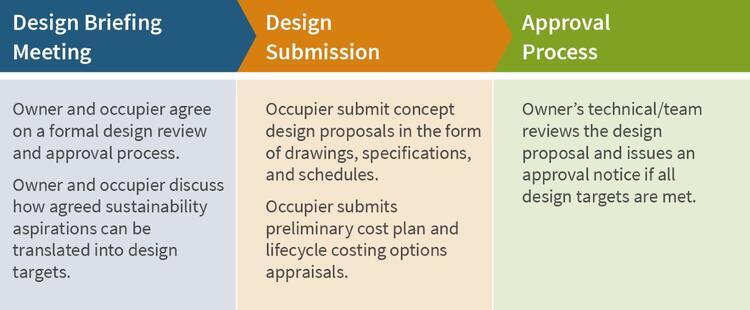Design Review & Sign-off
The processes linked to setting, agreeing and monitoring the design and specification are pivotal to the delivery of sustainable fit-outs.
Sustainability should run as a thread throughout this process. This will help to:
- Reduce the risk of the fit-out failing to meet any project sustainability requirements.
- Reduce the risk of conflicts between the fit-out and the base-build elements.
- Leverage the Owner's, and their representaives', invaluable knowledge of the base-building to guide beneficial and realistic design solutions.
- Ensure design solutions and specification decisions are optimised via ongoing review against the Requirements Brief.
- Ensure any value engineering process genuinely adds value rather that simply cuts costs.
1. Establish a Formal Design Review & Sign-Off Process
The owner and occupier should consider establishing a formal review and sign-off process, to support continual dialogue and engagement when developing the detailed design. The essential elements of this process will be common on most project types and scales, set out in the diagram below.

2. Agree Principles for the Design Review & Sign-Off Process
When creating a design development, review and sign-off process it is recommended that the following principles are considered. The amount and level of detail required in the information required for approval is an important issue. Every effort should be made to avoid any mismatch between owner and occupier expectations in this regard. Information should be relevant, timely and of a level of detail commensurate with the level of design.
Design Process Principles
1. Owner Representatives Attend a Design Briefing Meeting
Relevant representatives (e.g. base build designers, property management and sustainability advisors) can provide base-building information to the occupier’s design team. They can also communicate technical aspects of the owner’s sustainability aspirations and requirements, as well as offer valuable and practical guidance from past project experience. This approach can form part of a wider Soft Landings process and can be particularly helpful for occupiers who lack resources and experience.
2. Reflect Requirements Brief within the Design Specification
The occupiers sustainability requirements must form part of the brief to the design and delivery team. Their reflection of these requirements within the design specification and construction plan is a fundamental first stage of design assurance.
3. Agree the Extent of Information Required for Review
The amount and level of detail required for any approval process is an important issues to agree up-front. Specific considerations should include:
- How owner requirements and aspirations will be addressed (including reference to any Legal Agreement) and referencing any supporting documentation (i.e. drawings, specifications etc.).
- How risks associated with Minimum Energy Efficiency Standards will be mitigated e.g. copy of design stage EPC model.
- How targeted Fit-out Rating will be achieved e.g. the targeted rating based on the occupier’s design proposal, the processes in place for achieving certification and evidence that the design team have completed any necessary interim design stage certification.
- How HVAC and Lighting will deliver a comfortable and productive working environment in the most environmentally efficient manner and compliment existing base-building services. E.g. thermal comfort strategy and building services specifications.
- How the responsible procurement of Materials has been considered and will be implemented. e.g. evidence of materials specified or occupiers and contractor’s sustainable procurement policy.
- How the proposed contractor will minimise the environmental impacts during the Construction of fit-out works. e.g. evidence of a contractors Environmental Management System / on-site practices for resource efficiency; nuisance and pollution prevention / targeted score under the Considerate Constructors Scheme (CCS).
- How the delivery of the requirements be adequately transferred to the contractor, e.g. in relation to Construction Waste via a Site Waste Management Plan (SWMP).
- How operational and management arrangements have been considered?
- How Commissioning and Handover arrangements have been considered e.g. documentation associated with Soft Landings Framework or a commissioning plan.
4. Agree a Design Engagement Protocol
A design engagement protocol needs to be agreed between the occupier’s design team and the owner’s representatives.
The owner’s representatives can provide feedback and guidance on preliminary design options to ensure suitability with the base-build and value for the occupier. For example, highlighting where an occupier’s layout proposal within a naturally ventilated office would obstruct the natural flow of air which could result in overheating and occupant discomfort.
5. Occupier’s Review of Design Proposals Against Project Requirements
An internal review process to ensure design principles are met. This may include those set out within Legal Agreements, an owner’s fit-out guide or occupier's Requirements Brief. This review should take place prior to submitting the design proposals to the owner for approval.
6. Agree & Implement a Formal Design Submission & Sign-off Process
The owner's approval of the occupier’s proposed fit-out is a key project milestone. The aim should be to ensure the detailed design of the fit-out meets any minimum requirements agreed within any Legal Agreement. Depending on the scale and complexity of the fit-out, several approval points may be set to align with specific building elements and/or at different stages of design development.
At this stage owners should:
- Ensure that they have sufficient resource in place to properly review occupier’s proposals in a technically robust and timely manner.
- Be clear to the occupier on the level of detail sought, and when, in order in to facilitate a smooth process.
- Consider what approval protocols should be set for different status levels for design information submitted, e.g. “Approved; More Information Required, Not Approved”, This will enable partial approval and efficient focus on key areas.